In this post, we are going to look closely at working hours in a year, what they are, how we derive them, and how I can help you manage them smarter using Tivazo (my experience).
Understanding working hours in a year is not just mathematics; it is understanding how you use your time within the year. Whether you are an HR professional, a freelancer, a manager, or an employee of an expanding small business, understanding your annual working hours can help you plan more efficiently, avoid exhaustion, and maximize output. At Tivazo, we have found that tracking and analyzing working time annually can allow better schedules, healthy workloads, and mindful productivity. Let’s take a deeper look at how you can do the same.
Key Highlights:
- How Many Work Hours in a Year?
- How to Determine Work Hours in a Year
- Frequently Asked Questions Regarding Work Hours in a Year
- Competition Comparison: Where We Do Better
- Advance Calculations
- Considering Time Off
How Many Work Hours in a Year?
A standard U.S. 40-hour work week × 52 weeks = 2,080 work hours in a year.
Depending on how weekends are determined, days of the week land, some years may have 260 – 262 working days, giving, in total, closer to 2,096 work hours in a year.
However, this does not always reflect the entire picture. Most employees do not work on every single weekday because of Holidays, vacations, and intermittent days of illness. In the United States, the number of Federal Holidays annually has commonly been between 10 and 11 days of the year.
This number can bring the total number of actual working hours per year to a significantly lesser number of hours used, 1,960 to 2,000 yearly, in actual working hours based on company policies and individual benefits. To illustrate, if an employee receives fifteen (15) days of paid time off (PTO) or vacation, that drops their 2080 annual hours × 15 = 120 hours off of their annual total from working. Thus, that employee’s actual working hours in a year would amount to essentially 1,960 working hours in a year.
At Tivazo, we look at this type of information we gather based on this reasoning, not only for our internal scheduling purposes but, to assist teams in identifying realistic goals, aligning team workloads to avoid employee over-commitment and potential burnout from overestimating working hours.
How to Determine Work Hours in a Year
Generalized Formula
Work hours in a year = Weekly Hours × 52 weeks - (Time off days × hours/day )Table – Standard vs Reasonable
To calculate your work hours in a year, just deduct your vacation, sick days, and holidays accordingly
| Scenario | Weekly Hours | Work Hours in a Year | Comments |
| Standard full‑time | 40 | 2,080 | 52 weeks × 40 |
| With 10 vacation/public holidays | 40 | ~2,000 | Subtract 10 × 8 hours |
| With 20 vacation/sick days, | 40 | ~1,920 | 20 days off × 8 |
Frequently Asked Questions Regarding Work Hours in a Year
1. Do 2,080 hours include holidays?
No—the standard established by competitor sources indicates that 2,080 work hours in a year, by definition, do not allow for holidays, vacation, or sick days. 2,080 hours assumes an uninterrupted scheduled full-time, 40 hours a week, for 52 weeks, which is very rare. In practice, most employees receive between 10 and 20 days of paid time off (PTO)—significantly reducing the actual working hours per year. Therefore, if considering actual working hours, make sure to subtract the non-working days to arrive at a valid conclusion.
2. Is 2,000 hours of work a year?
Yes, if you subtract the expected time away—i.e., 10 vacation days (80 hours), you get nearly 2,000 hours of work a year. A lot of organizations may use this as a practical standard rate for budget and resource planning, because it gives a more balanced workload. At Tivazo, we will use this figure to plan for total project capacity, and not to overstress our teams.
3. How many hours is a 40-hour work year?
A 40-hour week translates into 2,080 working hours in a year. However, the U. S. averages out closer to 38 hours/week, which results in 1,976 hours of work in a year. This slight reduction encompasses holidays, paid time off, and flexible schedules—taking this into account enables better adjustments. Especially if Shair, Karan, and Scott use the work schedules to help them use Tivazo to record and optimize adjusted work hours.
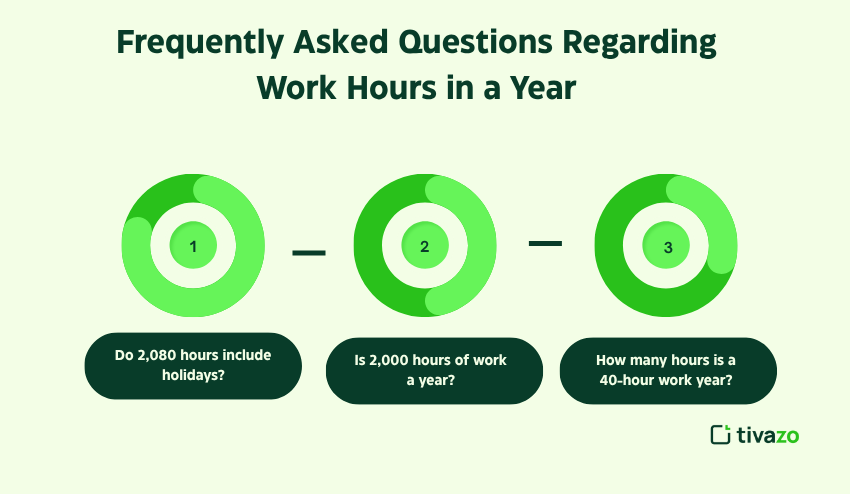
Competition Comparison: Where We Do Better
I looked at the top articles in The Forage and Clockify, which looked at:
- Standard math (40 × 52 = 2080)
- Holidays, vacation time influence
- Some tables and FAQs to help readers
But let’s take it a step further than any competitor.
For example, at Tivazo, not only do we have this math—we put it into the real workflows. For example, Tivazo’s time tracking tools support teams in understanding how time was spent in a task, rather than just how we may think time was spent, and figuring out where the hidden inefficiencies are that add up and lead to unnecessary work hours in a year. One example has been with our Dev team, which revealed they had participated in meetings totaling just under 6 hours a week that were not well aligned.
That amounted to well over 300 hours of work in a year led. They could sustain less time in meetings, while on the project, lose an hour a week of total project time, which results in wasted time and an impact on the budget if there is a chance for the wasted time.
SEO best practices
- We provide actual user answers in headings like “Is 2,000 hours a year work?”
- We use structured content with tables and bullet points to enhance readability and time on page
- We use the keyword work hours in a year in multiple places naturally for better search visibility
And, most importantly, we keep referring back to actionable insights powered by Tivazo, creating content that is not merely informative, but transformative.
We go beyond just that. We utilize the power of storytelling. “At Tivazo, I was shocked that I spent 150 hours every year in status meetings that were not necessary…” That became a tipping point. We used Tivazo dashboards to redesign systems, and that drove a much more deliberate and effective use of time.
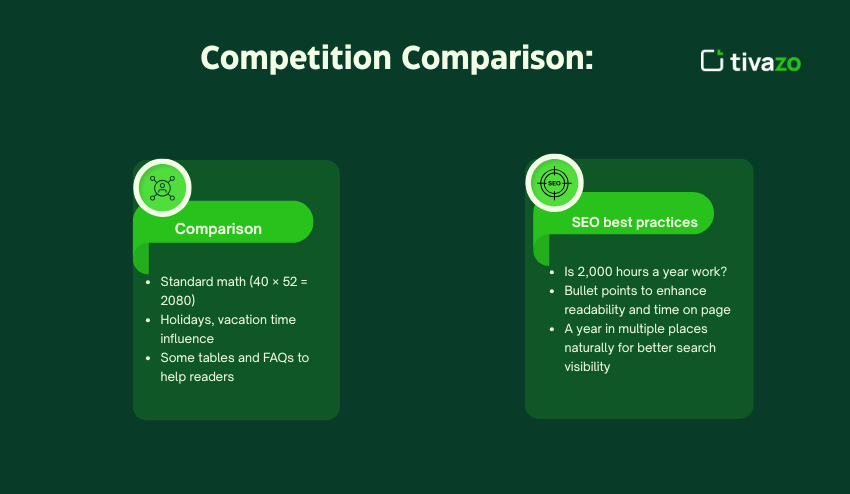
Advanced Calculations- Customized Work Hours in a year
If you work irregular hours, you can still do these calculations:
| Weekly Hours | Work Hours in a Year (×52) |
| 35 | 1,820 |
| 37.5 | 1,950 |
| 45 | 2,340 |
| 50 | 2,600 |
| 60 | 3,120 |
The above chart is particularly useful for freelancers, part-time employees, gig workers, or other professionals who will work long hours because their work is demanding, such as consultants or at a tech company. For example, if they are working 45 hours per week for a short-term, high-demand project, they could work over 2,300+ work hours in a year, but the standard number is only 2,080. This is where Tivazo comes into play.
We take care of the details for these professionals, and we help them monitor and manage their workloads. Not only do our tools help visualize recorded hours and minutes, but we also illustrate trends over time. This results in more active management and timely decisions if their work hours in a year get too high.
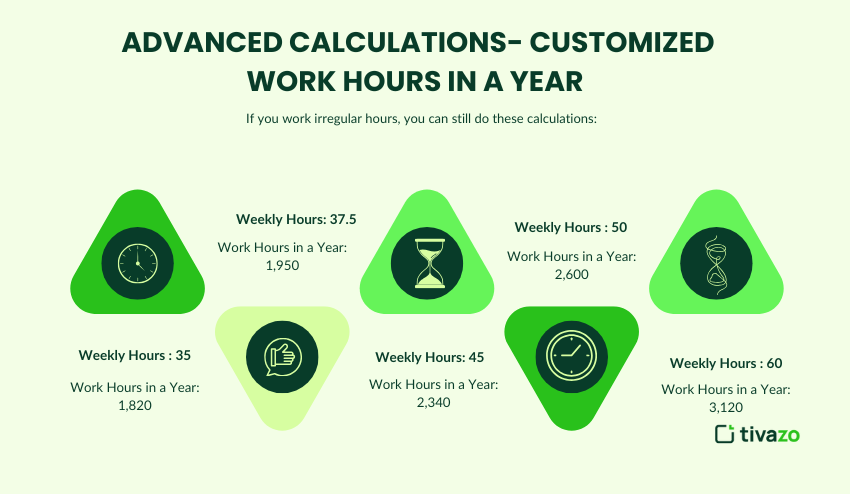
Considering Time Off
After you have your base total:
Adjusted work hours in a year = Base annual hours - (time off days x hours worked/day)The purpose of this formula is to give you a more realistic view of your actual work hours in a year versus the theoretical 2,080 hours. To determine an accurate total, you need to subtract your time off, including public holidays, vacation days, personal leave days, sick days, or any other time off, including company-sanctioned shutdowns or furloughs. In the example we outlined earlier, if you receive 10 vacation days, 5 sick days, and 10 public holidays, that would mean 25 days. That times 8 hours a day will subtract 200 hours, for an overall adjusted work hours in a year tally of 1880 hours!
At Tivazo, we encourage all members of the team to calculate their real availability. This will create a more accurate level of project planning, which ultimately promotes healthy work habits. With Tivazo’s savvy time tracking, we help align capacity with goals, ensuring nobody is on the edge of burnout, yet we still keep the train moving forward!
How to See How Many Hours You Worked in a Year
To see how many work hours in a year you have all depends on how you track your time. The easiest way is to multiply your average weekly hours by 52. For example, if you work 40 hours a week all year and don’t take any time off, that comes out to 2,080 work hours in a year. But this does not take into consideration holidays, vacations, sick days, or unpaid time off.
A more useful alternative is to utilize a time tracking software tool (e.g., Tivazo) to track the day-to-day work that you achieve, which will then track and report to you on your actual work hours in a year. You can view a report on all of the detailed time spent on each project, meeting time, and time off.
This is very important for managing your productivity and avoiding burnout, and knowing your true workload. Whether you are a freelancer billing clients, an HR person managing capacity, or an employee setting objectives, knowing how many hours you worked in a year makes sure you are working smarter, not harder.
Tivazo & Personal Angle – Work Hours Per Year
My Tivazo Story
At Tivazo, I started calculating my work hours per year: I logged about 2,080 hours/year. If you count the ~15 vacation days, I worked around 1,960 work hours in a year. But the real “duh moment” happened when I started using Tivazo and its internal analytics. This is 5 full weeks of work lost!
We kicked off an audit of meetings across the company. Each department was tasked with categorizing, scoring, and optimizing meetings. We got rid of unnecessary weekly syncs and moved towards asynchronous updates where we could. Within the first quarter, every team member saved on average 50+ work hours in a year, which can be spent on more important work and learning.
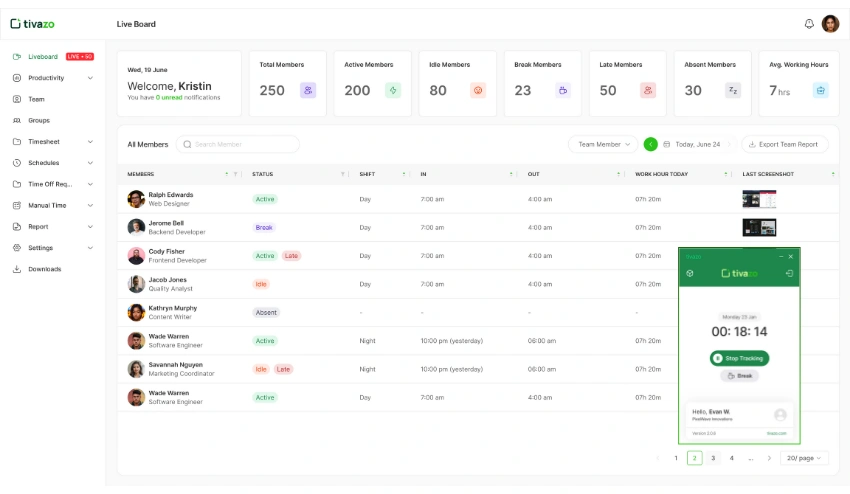
How Tivazo helps cut work hours in a year
Tivazo is one app that doesn’t just track time, but helps you make time better. Its usage will allow you to work smarter and not longer. Tivazo helps teams set healthy work boundaries, reduce the time that gets wasted, and take everyone towards fewer work hours in a year with the goal of more impact.
1. Action Plan -Manage Work Hours in a Year
- Track your hours each week for one month. This gives you a starting point to see how many hours you work and where that time goes. You can get very detailed in your reporting with Tivazo’s hour tracking functionality.
- Develop an estimate of how many hours you work in a year (×52).
- Multiply your average total weekly by 52 weeks to get your estimated work hours in a year.
2. Log your PTO/vacation/holiday days.
- Log holidays and vacations, etc.. Then subtract those from your estimate to arrive at your adjusted hours.
- Subtract to find how many realistic work hours you can expect in a year.
- Use this number to help you plan for projects and your workload expectations.
3. Use Tivazo analytics
- help you understand where you are working, a week where meetings are taking up lots of your time, and you are wasting hours.
- Tivazo helps you see how much time you spend in meetings, etc., as compared to your deep work hours, and helps you remove those low-value tasks from your life.
4. Set a goal:
- Keep your work hours in a year under 2,000.
- This keeps you productive while also being work/life balanced.
5. Assess quarterly:
- Compare your recorded work hours with your estimated work hours in a year.
Tivazo has automated reporting to help you track whether you are on schedule and recalibrate your workload in any given quarter.
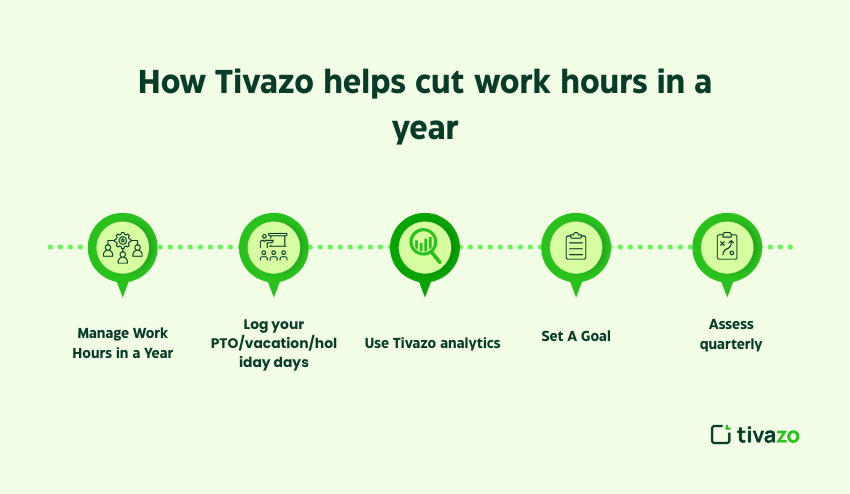
Conclusion
Once you’re measuring your hours accurately and factoring in vacation and holidays, combined with your work-life balance data in Tivazo, you can identify inefficiencies, eliminate some burnout from workload, and increase your focus on what’s important. At Tivazo, we know time is the most valuable resource you have, and with the right information, it’s easier to work with it as originally intended.
Calculating your work hours in a year is more than just calculating a number; it is about taking command of your time, energy, and objectives. It doesn’t matter if you are managing a group of people, developing a company, or just trying to find a better work-life balance; knowing the hours you put in a year can provide the mental clarity to contribute to a better decision-making framework.
So, don’t guess your work hours in a year. Measure them, optimize them, and own your productivity. What’s the result? A healthier, better-balanced approach to work, which contributes to long-term success.




